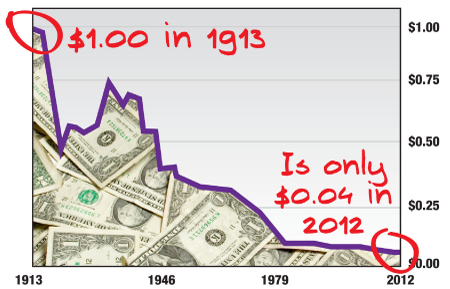Monday, October 19, 2015
Feeding American Christians to the Lions: The Six Stages of Christian Persecution
“If the world hates you, keep in mind that it hated me first. If you belonged to the world, it would love you as its own. As it is, you do not belong to the world, but I have chosen you out of the world. That is why the world hates you. Remember what I told you: ‘A servant is not greater than his master.’ If they persecuted me, they will persecute you also. If they obeyed my teaching, they will obey yours also. They will treat you this way because of my name, for they do not know the one who sent me.”
John 15:18-21
The Anti-Christian Terrorist Network
Recently, and while campaigning in Massachusetts, Donald Trump stated that America was “going to hell”. Truer words were never spoken.
We are now five days removed when the low-life Southern Poverty Law Center (SPLC), and they are ordered to watch Christians and anyone else who might dare to disagree with the government.
Assistant Attorney-General John Carlin, head of the Department of Justice’s (DoJ) National Security division, announced this unholy deal with the SPLC on Wednesday.
The announcement was very specific as Carlin announced the government was going to persecute and prosecute the KKK, people who would engage in violence and anyone who held anti-government views. Most disturbingly, Carlin expressed frustration with having to follow due process when prosecuting the newest definition of domestic terrorism. If you have been away on vacation and missed this Gestapo type message, may I suggest you click here and here and catch up on the news you missed over the past few days.
Christians and the Obama Administration Are Natural Enemies
Who could ever forget the Hobby Lobby debacle in which Obamacare’s policies attempted to make any organization, including Christian organizations and private business interests acquiesce to its anti-Christian world-view and forcibly dispense birth control to its employees.
Although no officials are calling persecution of gays, Christian church doctrine is quite clear on the subject. Yet, Christians are being forced to not only accept the tenants of the LGBT, Christians are being forced to enthusiastically embrace the lifestyle in its business practices (e.g. the making of wedding cakes for gay marriages to the indoctrination being offered by some educational institutions to newest form of perversion which has come to America in the gender neutral bathrooms in which any pervert can invade the restroom of the opposite gender). Tolerance is one thing, forced acceptance is quite another. When Christians speak out against this forced acceptance, which emanates from liberal bureaucrats in Washington DC, this casts Christians in the untenable position as being anti-government. And according to the SPLC and Assistant Attorney General Carlin, this makes Bible-Believing Christians a band of domestic terrorists.
The Six Stages of Religious Persecution
Monsignor Charles Pope along with Johnette Benkovic developed a systematic theory of religious persecution. Both men point out, that the persecution of a targeted faction of society begins slowly and incrementally increases stage by stage. According to this theory, American Christians should be very cognizant that they are well into the first stages of extreme religious persecution which is sponsored by the Obama administration.
Stage one commences with attempts to stereotype the targeted group. In the aforementioned paragraphs, it is quite clear that Obama views Christians with disdain. After all, Obama announced that America is no longer a Christian nation. Also, in 2008, he categorized working-class voters in the following way: “It’s not surprising, then, that they get bitter, they cling to guns or religion or antipathy to people who aren’t like them or anti-immigrant sentiment or anti-trade sentiment as a way to explain their frustrations.”
According to Obama’s world view, people of faith are the inhibitors of “progress,” and they deserve being described as Bible-thumpers, and therefore ignorant, intolerant followers of Jesus Christ. With Carlin’s proclamations, our Christian views will soon come under extreme attack.
The second stage of persecution involves justifying hatred of a particular group. Just as soon as Carlin’s DOJ domestic terrorism task force swings into action, Christians will receive the terrorist label that the Obama administration believes that they so badly deserve. It is interesting the Carlin’s forces have partnered with the SPLC. They are so radical and so violent that even the FBI stopped using them as a source of information.
Stage three involves the marginalizing of Christians’ role in society. This is what Hitler did to the Jews as he first denied them employment in key areas of banking and education. It is at this time that every wrong act committed by a Christian will be highly vilified and publicized. It will be at this point that astute and aware Christians will be forced to go underground to practice their faith. With the church increasingly following under the domination of the Clergy Response Team, in which your pastor is an employee of the Department of Homeland Security, the church could soon be an unsafe place for Bible-believing Christians. Oh, there will still be churches, just not any churches that we would recognized as being Christian. I firmly believe that Carlin’s task force will usher in the first three stages of this approach to Christian persecution.
The fourth stage of Christian persecution involves criminalizing Christians and their churches, businesses, and educational institutions. Christians will be held up as the model for what is wrong with America with its intolerance for the free expression of every deviant lifestyle and social expression of sinful behavior. Hillary Clinton, who recently stated at the Sixth annual Women in the World Summit that “deep-seated cultural codes, religious beliefs and structural biases have to be changed” for the sake of giving women access to “reproductive health care and safe childbirth.
The fourth stage of Christian persecution involves criminalizing Christians and their churches, businesses, and educational institutions. Christians will be held up as the model for what is wrong with America with its intolerance for the free expression of every deviant lifestyle and social expression of sinful behavior. Hillary Clinton, who recently stated at the Sixth annual Women in the World Summit that “deep-seated cultural codes, religious beliefs and structural biases have to be changed” for the sake of giving women access to “reproductive health care and safe childbirth.
Stage six ushers in the direct persecution of Christians. The time for marginalizing Christians stops and the outright, undeniable persecution begins. Churches will be forced to marry gays and will be forced to formally accept the validity of the teaching of every other religion (e.g. Islam), or be found guilty of a hate crime. Pope notes, even jail time for Christians is quite possible: “Already in Canada and in parts of Europe, Catholic clergy have been arrested and charged with ‘hate crimes’ for preaching Catholic doctrine on homosexual activity.” Stage six will mark the beginning of the elimination of Christianity as a mainstream, viable religion.
Open Doors stated that Christians are the most persecuted religious group worldwide. An average of at least 180 Christians around the world are killed each month for their faith.
Credit to Common Sense
 The United States Department of State stated that Christians in more than 60 countries face persecution from their governments or surrounding neighbors simply because of their belief in Christ.
The United States Department of State stated that Christians in more than 60 countries face persecution from their governments or surrounding neighbors simply because of their belief in Christ.
Open Doors also stated that in 41 of the 50 worst nations for persecution, Christians are being persecuted by Islamic extremists. As previously noted by this author, the Obama administration is filled with high ranking government employees who have ties to the terrorist group known as the Muslim Brotherhood.
What Is a Good Christian to Do?
Under the coming edicts of Carlin, Christians will soon be faced with a choice between giving in, to standing up for one’s beliefs and be “fed to the lions”, or, to take their religious practices underground. Going underground seems to be the wisest of all choices. However, how far behind can the Mark of the Beast be?
WalMart Suppliers Brace For The Coming Storm
When Wal-Mart moved to hike wages for its lowest paid employees earlier this year, we were quick to note that the fallout would end up rippling through the supply chain. Here’s what we said in April:
The irony is that while WMT (or MCD or GAP or Target) boosts the living standards of its employees by the smallest of fractions, it cripples the cost and wage structure of the entire ecosystem of vendors that feed into it, and what takes place is a veritable avalanche effect where a few cent increase for the lowest paid megacorp employees results in a tidal wave of layoffs for said megacorp's vendors.
Subsequently, the retailer embarked on a series of efforts to extract every last penny of savings from suppliers including i) an effort to compel vendors to forgo marketing expenditures, ii) adding storage fees and manipulating payment schedules, and iii) demanding that suppliers pass along any savings from China’s yuan devaluation.
As we’ve been at pains to explain, this was absolutely inevitable.
When “everyday low prices” is the corporate religion, you can’t pass along rising labor costs to consumers. Add it the fact that WalMart’s customers largely belong to the same tax bracket as the company’s meagerly compensated hourly employees and raising prices simply is not an option.
That means either suppliers suffer, hours are cut, people get laid off, or all of the above.
At Wal-Mart, it’s been all of the above, as workers at some stores report reductions in hours and the Bentonville office looks to cut hundreds of management level positions.
Meanwhile, some of the retailer’s higher paid workers have become disgruntled at the company’s failure to preserve the wage hierarchy (i.e. when you summarily hike wages for one group of employees and not others, you have distorted the pay ladder).
Now, after last week’s dramatic guidance cut and subsequent stock price plunge, suppliers are bracing for the worst. Here’s Reuters:
Suppliers of everything from groceries to sports equipment are already being squeezed for price cuts and cost sharing by Wal-Mart Stores. Now they are bracing for the pressure to ratchet up even more after a shock earnings warning from the retailer last week.The discount store behemoth has always had a reputation for demanding lower prices from vendors but Reuters has learned from interviews with suppliers and consultants, as well as reviewing some contracts, that even by its standards Wal-Mart has been turning up the heat on them this year."The ground is shaking here," said Cameron Smith, head of Cameron Smith & Associates, a major recruiting firm for suppliers located close to Wal-Mart's headquarters in Bentonville, Arkansas. "Suppliers are going to have to help Wal-Mart get back on track."For the vendors, dealing with Wal-Mart has always been tough because of its size – despite recent troubles it still generates more than $340 billion of annual sales in the U.S. That accounts for more than 10 percent of the American retail market, excluding auto and restaurant sales, and the company increasingly sells a lot overseas too. To risk having brands kicked off Wal-Mart’s shelves because of a dispute over pricing can badly hurt a supplier.On Wednesday, Wal-Mart stunned Wall Street by forecasting that its earnings would decline by as much as 12 percent in its next fiscal year to January 2017 as it struggles to offset rising costs from increases in the wages of its hourly-paid staff, improvements in its stores, and investments to grow online sales. This at a time when it faces relentless price competition from Amazon.com Inc dollar stores and regional supermarket chains.Keeping the prices it pays suppliers as low as it can is essential if it is to start to claw back some of this cost hit to its margins.
Speaking of Amazon, recall the following which we posted in the aftermath of the guidance cut:
Back to Reuters:
The squeeze on suppliers was clear to those selling to Wal-Mart’s Sam’s Club warehouse clubs around April this year. Sam’s Club’s buyers summoned major vendors to meetings and told them a "cost gap analysis" showed they should be delivering at a lower price, and demanded millions of dollars in discounts on future purchases, according to emails reviewed by Reuters and interviews with suppliers and consultants involved in the talks.Unlike in prior talks, which featured give and take, vendors were told they could not ask questions at the meetings, with queries to be handled later via email, according to suppliers and consultants involved in or briefed on the meetings.
Yes, no questions allowed, and as we've pointed out before, WalMart can sadly get away with this type of approach to dealing with vendors because after all, if you're a supplier, you're not going to cut your nose off to spite your face by rebelling against your largest revenue stream. Or, as Leon Nicholas, a senior vice president at Kantar Retail, which advises Wal-Mart suppliers put it last month, "you can push and push, but at the end of the day you know where the power lies."
And after last week's carnage, the supply chain is finally beginning to understand why WalMart has become even stingier than normal.
Wednesday's announcement sent ripples through the supplier community in the Bentonville area, where more than 1,000 have offices to stay close to Wal-Mart."Now we know why they have been pushing so hard," said an executive at a major consumer goods supplier to both Walmart and Sam's Club, adding that his team was shocked by the projected decline in profits. "Maybe they were banking on more suppliers rolling over on the terms."Wal-Mart's success in boosting profits could hinge in large part on the willingness of suppliers to sign on to its new terms and agree to its price demands. Despite signs of resistance, one consumer goods supplier reckons most will eventually give in to Wal-Mart’s market power, though not without a fight.He pushed back after the retailer asked him for new terms that cut 2 percent off his annual sales. They settled on 1 percent, but he fears further demands down the road.“I just worry that this is a slippery slope of them going in this direction," he said.
A slippery slope indeed, much like the slippery downward slope the company's earnings seem to be on, and between the above mentioned pressure from online retailers and fierce competition from no frills dollar stores, one is left to wonder if perhaps WalMart's move to hike wages may have set the legendary discounter on a path to becoming the next K-Mart.

Credit to Zero Hedge
Dollar Moves Shake The World: "Federal Reserve Could Start A Currency War"
There is a war, a currency war, and the war is, ultimately, on us.
In many respects, Americans have fallen far, and hard, from the liberty they once had.
Rather than living under a sound currency, modern Americans live under an economic despotism. There are monopoly men who tightly control the money, and are all the more insidious in their subtlety, and quietness in the shadows.
Today, things are so bad that they face economic enslavement and a rapid theft of their wealth through the debasement of the dollar’s value.Not only is the destruction of the dollar systematic and planned, but it is designed to leave Americans holding the bag. The money passes round and round, but it trickles down from the big banks, who are loaned the money free at zero percent interest by the Federal Reserve under its QE program, created to “fix” the 2008 economic crisis that nearly brought the world to its knees.
Now, literally any action at all – especially including no action – by the Federal Reserve has a direct impact on the value of the U.S. dollar, and greatly determines the course of world events, and especially whether or not average people can pay the bills.
According to The Street, it is an all out currency war that will have direct impact on budgets large and small:
The stock market stays high because the Fed is not going to raise short-term interest rates. The Fed is not going to raise short-term interest rates because the U.S. inflation rate remains low. The inflation rate remains low because the value of the U.S. dollar is high. The dollar is strong because world commodity prices have fallen and have “driven up the dollar and held down U.S. import prices.”According to the Financial Times, the last three items mentioned are interrelated. Furthermore, it now seems as if momentum is picking up within the Federal Reserve to postpone any increases in it policy rate for an extended period of time. That inaction may not be the best decision in terms of the relative strength of currencies.[…]According to this argument, the stock market should begin to fall because the Fed is raising interest ratesThe key connector here seems to be the relationship between the value of the U.S. dollar and any action that the Federal Reserve might take on raising short-term interest rates.
The Fed is the only thing propping the stock market up – when, or if, it moves, there will be a crash, that will call bad debtors and impoverish entire social security systems. But things aren’t much better if they stay still, either. According to The Street:
[I]f the Fed does not raise its target policy rate, other countries will have to take further action to ease up further on their economic policies. The European Central Bank will extend its quantitative easing. The Bank of England will not raise its policy rates.The Peoples Bank of China will attempt to achieve further ease so that the renminbi will fall against the U.S. dollar.In effect, this looks like a currency war, and the world cannot afford a currency war at this time.The Federal Reserve needs to take these things into consideration in making their policy decisions. They are, after all, the global reserve currency and they cannot avoid the responsibilities that go along with this position.[…]If the Federal Reserve does not raise interest rates, the value of the US dollar will fall and this will have an impact on the commodity prices of emerging nations, causing import prices and U.S. inflation to rise.
How did the Federal Reserve get so much power over the American economy – and that of the world’s? There have been many stages of the theft which are too numerous to list, but which are generally well known to those familiar with its odious origins as a design by the banking cartel.
Started under conspiratorial circumstances back in 1913, the Federal Reserve has established itself as a private central bank for the country, though it is not part of the U.S. government. Since its inception, the Fed has driven the dollar down to just a fraction of its original value.

Since the U.S. went off the gold standard under the shadow presidency of Henry Kissinger in 1971, the dollar has plummeted in status to a worthless piece of paper. Meanwhile, however, the dollar was the world reserve currency, and was the currency that traded for oil during a time of supply crisis, it has retained an accepted – and therefore valued – status so long as America dominated foreign policy (in part by managing more and more wars) and maintained its status.
The banksters operated the monetary and financial system that led the world by trading in petrodollars, and in turn, forced oil rich nations like Saudi Arabia to invest on Wall Street, as well as reluctant powers like Japan, who were forced to open up their markets to foreign investment during the oil crisis.
But now world power is shifting. The dollar is dying, and the Federal Reserve has become a leviathon that is too big to die, and too bloated to be effective. In its enormous capacity, it is facilitating the theft of TRILLIONS and TRILLIONS of dollars from the American people:
Americans face a further decline in their standard of living in all cases, market-wide conditions that the Fed alone can determine. Their wealth is rapidly evaporating.
If the Fed raises rates, the market will crash. On the otherhand, if it doesn’t raise rates, and continues indefinitely on its course of quantative easing, investors, middle class and working families, businesses, as well as pensions, benefit programs and insurance policies will also die a slow painful economic death.
Already things are hovering dangerously on edge, and squeezing in tightly.
Credit to Zero Hedge
Wal-Mart’s Worst Stock Crash In 27 Years Is Another Sign That The Economy Is Rapidly Falling Apart
 Now that a major global recession has begun, you would expect major retailers like Wal-Mart to run into trouble as consumer spending dries up, and that is precisely what is happening. On Wednesday, shares of Wal-Mart experienced their largest single day decline in 27 years after an extremely disappointing earnings projection was released. The stock was down about 10 percent, which represented the biggest plunge since January 1988. Over 21 billion dollars in shareholder wealth was wiped out on Wednesday, and this was just the continuation of a very bad year for Wal-Mart stockholders. Overall, shares had already declined by 22 percent so far in 2015 before we even got to Wednesday. Here is more on this stunning turn of events from Bloomberg…
Now that a major global recession has begun, you would expect major retailers like Wal-Mart to run into trouble as consumer spending dries up, and that is precisely what is happening. On Wednesday, shares of Wal-Mart experienced their largest single day decline in 27 years after an extremely disappointing earnings projection was released. The stock was down about 10 percent, which represented the biggest plunge since January 1988. Over 21 billion dollars in shareholder wealth was wiped out on Wednesday, and this was just the continuation of a very bad year for Wal-Mart stockholders. Overall, shares had already declined by 22 percent so far in 2015 before we even got to Wednesday. Here is more on this stunning turn of events from Bloomberg…Wal-Mart Stores Inc. suffered its worst stock decline in more than 27 years after predicting a drop in annual profit, underscoring the giant retailer’s struggles to reignite growth.Earnings will decrease 6 percent to 12 percent in fiscal 2017, which ends in January of that year, the Bentonville, Arkansas-based company said at its investor day on Wednesday. Analysts had estimated a gain of 4 percent on average, according to data compiled by Bloomberg.
If it was just Wal-Mart that was having trouble, that would be bad enough. But the truth is that signs that the U.S. economy has entered another major downturn are popping up all around us. Just consider the following list of economic indicators that Graham Summers recently put out…
The Fed has now kept interest rates at zero for 81 months.
This is the longest period in the history of the Fed’s existence, lasting longer than even the 1938-1942 period of ZIRP.
And the US economy is moving back into recession. Consider that…
1) Industrial production fell five months straight in the first half of 2015. This has never happened outside of a recession.
2) Merchant Wholesalers’ Sales are in recession territory.
3) The Empire Manufacturing Survey is in recession territory.
4) All four of the Fed’s September Purchasing Manager Index (PMI) readings (Philadelphia, New York, Richmond, and Kansas City) came in at readings of sub-zero. This usually happens when you are already 4-5 months into a recession. (H/T Bill Hester)
Another huge red flag is the fact that month after month fewer products are being shipped around the country compared to last year.
If less stuff is being shipped around by truck, rail and air, is it a sign that the economy is getting better or is it a sign that the economy is getting worse?
The answer, of course, is self-evident. With that in mind, please read the following excerpt which comes from a recent article by Wolf Richter…
It has been crummy all year: With the exception of January and February, the shipping volume has been lower year-over-year every month!The index is broad. It tracks data from shippers, no matter what carrier they choose, whether truck, rail, or air, and includes carriers like FedEx and UPS.Evidence keeps piling up in the most unpleasant manner that something isn’t quite right in the real economy. The world is now in an inexplicable slowdown – “inexplicable” for central bankers who’ve cut interest rates to zero or below zero years ago, and who’re still dousing some economies with QE even as governments are running up big deficits. And yet, despite seven years of this huge monetary and fiscal stimulus, the global economy is deteriorating.
Okay, so is there anyone out there that still believes that the U.S. economy is in good shape?
The Obama administration will probably not admit it for a very long time, but the truth is that the numbers very clearly tell us that we are in a recession.
Anybody out there, whether an “expert” or just someone you happen to know, that tells you that everything is just fine is either completely ignorant or they are purposely lying to you.
And just like in 2008, state and local governments are starting to get into tremendous financial trouble as the real economy sputters. For example, the governor of Illinois has told reporters that “we are out of money now” and that pension fund payments will be delayed as a result…
Illinois will delay payments to its pension fund as a prolonged budget impasse causes a cash shortage, Comptroller Leslie Geissler Munger said.The spending standoff between Republican Governor Bruce Rauner and Democratic legislative leaders has extended into its fourth month with no signs of ending. Munger said her office will postpone a $560 million retirement-fund payment next month, and may make the December contribution late.“This decision is choosing the least of a number of bad options,” Munger told reporters in Chicago on Wednesday. “For all intents and purposes, we are out of money now.”
When these sorts of things started happening in 2008, Fed Chairman Ben Bernanke and the Bush administration went into full-blown denial mode. They kept telling all of us not to worry and that everything would be okay, and that just made things worse in the end.
The same thing is happening now. The Obama administration and the mainstream media keep talking about an “economic recovery” even in the face of numbers such as I have discussed in this article.
Perhaps things are going well for you personally at the moment, and that is great. But now is not the time to buy lots of new toys. Nor is it the time to accumulate more debt.
Instead, now is a time to position yourself for a period of difficulty that could stretch on for years.
The next recession is here, and it is going to grow progressively worse.
The wise will take heed and make preparations, but the foolish will just keep on doing what they have been doing until it is far too late.
Credit to Economic Collapse
With US Warships En Route To Islands, China Asks: "What On Earth Makes Them Think We Will Tolerate This?"
The US is in a tough spot militarily.
In Syria, Russia and Iran have taken advantage of the fact that the plan hatched by the West and its regional allies to destabilize the Assad regime took far too long to develop. The idea was to foment discord and provide covert support for the various armed militias fighting to overthrow the government. But the effort is entering its fifth year and Assad is still there.
Not only that, there have been a series of unintended (well, at least we hope they’re unintended) consequences. First, one of the rebel groups the West and its allies supported morphed into an insane band of white basketball shoe-wearing, black flag-waving, sword-wielding desert bandits. Second, the fighting created a horrific refugee crisis that now threatens to destabilize the whole of Europe. Sensing a historic geopolitical opportunity, Moscow and Tehran simply stepped in and outmaneuvered Washington. Now, the US basically has to decide whether it wants to go to war with Russia, because paradropping ammo into the middle of the desert isn’t going to be a viable strategy.
Meanwhile, the US faces another superpower confrontation in the South China Sea.
When Beijing began its land reclamation efforts in the Spratlys, we’re reasonably sure the Pentagon didn’t anticipate the extent to which the effort would quickly become a giant headache for Washington.
As a reminder, it’s not so much the dredging that has Washington’s regional allies in the South Pacific upset. Island building has been done before in the area. Rather, it’s the scope of the project that has everyone unnerved as Beijing has so far constructed over 3,000 acres of new sovereign territory atop which China has built everything from cement factories, to greenhouses, to runways.
Whether or not the US really cares about this is debatable although these shipping lanes are indeed critical for world trade. But with The Philippines and others crying foul, Washington is left with little choice but to put on a brave face lest the world should get the idea that China can just redraw maritime boundaries at will and establish a Sino-Monroe Doctrine in the process.
So finally, the US decided that it would sail some warships by the islands just to see if it can do so without getting shot at.
No, really. That’s the whole plan. “Let’s see how far we can push them.”
This is of course orchestrated under the guise of a freedom of navigation operation which, in a way, makes little sense because China has never threatened global trade. Then again, it’s fairly obvious that Beijing has some military role for the new islands in mind.
In any event, China hit back on Thursday, saying the PLA would “stand up and use force” if necessary should the US make a “mistake” with the whole warship plan.
So in short, Washington is now in a staring contest with both Moscow and Beijing and both Russia and China seem to have gotten the idea that the US has lost its resolve lately and will probably blink first in both standoffs.
It’s with all of that in mind that we bring you the following rather amusing op-ed from Beijing out Saturday on Xinhua, presented below with no further comment:
* * *
Via Xinhua
The United States' provocative attempts to infringe on China's South China Sea sovereignty are sabotaging regional peace and stability and militarizing the waters.The U.S. Navy is reportedly preparing to conduct "freedom of navigation" operations, sending warships within 12 nautical miles of Chinese islands in the South China Sea. The U.S. operations may take place within days, according to reports.Last month, in his response to China's claim of sovereignty over the South China Sea, U.S. Secretary of Defense Ash Carter said the United States "will fly, sail and operate wherever the international law allows, as we do around the world."White House Spokesman Josh Earnest said on Oct. 8 that U.S. warships patrolling close to artificial islands built by China in the South China Sea "should not provoke significant reaction from the Chinese."Let us not forget that in October 1962, when the Soviet Union was building missile sites in Cuba -- not even on U.S. soil -- U.S. President Kennedy made it clear in a televised speech that the United States would not "tolerate the existence of the missile sites currently in place."What on earth makes the United States think China should and will tolerate it when U.S. surface ships trespass on Chinese territory in the South China Sea?China will never tolerate any military provocation or infringement on sovereignty from the United States or any other country, just as the United States refused to 53 years ago.China's stand on the South China Sea disputes is firm and clear. China's sovereignty and claims of rights over Nansha Islands and their adjacent waters in the South China Sea have been formed over the long course of history and upheld by successive Chinese governments, and have adequate and solid historical and legal basis.Just as Article 15 of the United Nations Convention of the Law of the Sea stipulates, delimiting the territorial seas of China and other countries in the South China Sea shall be in accordance with China's "historic title" to the region.China has always been, in a constructive and effective manner, a firm upholder of the freedom of navigation as well as peace and stability in the South China Sea. And China has vowed to continue to do so in the future.China's construction of civilian and public facilities on the Nansha Islands and reefs, which fall within the scope of China's sovereignty, serves not only China but also coastal nations in the South China Sea.For instance, two lighthouses recently built on reefs in the region have helped guide passing vessels from around the world and significantly improved navigation safety.Contrary to U.S. claims, it will be the United States, as an outsider, that further provokes tensions in the South China Sea by sending soldiers and warships to Chinese territory in the name of "freedom of navigation."This is not the first move by the United States to undermine the regional peace and stability that China has worked so hard for.Over the past several years, the United States has held frequent large-scale drills with its allies in the South China Sea, flexing their military muscles.According to the website of the U.S. Department of Defense, the country has deployed thousands of civilian and military officials, as well as a huge number of weapons, to the Pacific region.To destabilize the region and contain China, the United States has deliberately involved non-party nations, such as Japan, in the South China Sea issue and stirred disputes between China and other parties, including the Philippines.By no means will China let the provocateurs make waves in waters that should be characterized by peace, friendship and cooperation.Last year, the bilateral trade volume between China and members of the Association of Southeast Asian Nations (ASEAN) exceeded 480 billion U.S. dollars.Concerned nations have no alternative but to jointly deal with disputes in the South China Sea that pose a threat to the development and prosperity of parties in the region.On Sept. 18, in response to remarks made by the commander of U.S. forces in the Pacific on patrolling the South China Sea, a Chinese foreign ministry spokesman said China, like the United States, upholds freedom of navigation in the waters.However, the spokesman stressed, China opposes any country's challenge, in the name of freedom of navigation, to China's sovereignty and security in the South China Sea.During a visit to Europe in March 2014, Chinese president Xi Jinping stressed that his country will "never stir up any trouble, but will resolutely safeguard its legitimate rights" when it comes to sovereignty and territorial integrity.Even though enhancing mutual trust and managing disputes through high-level visits and talks still remains the first option for China, the country will, without any doubt, adopt countermeasures against the United States if it doesn't stop military provocations that infringe upon China.People with vision in Washington should and must see clearly China's determination in safeguarding national sovereignty and regional security.Credit to Zero Hedge
The day China says its currency is backed by gold
It’s common knowledge the Chinese have about $2 trillion in foreign currency reserves. What a nice, fat bank account.
Donald Trump has gained a lot of airtime recently talking about how China has been ripping off the United States over the previous decades, artificially devaluing the yuan and protecting China’s own companies at the expense of ours, stealing our technology, and attacking our infrastructure via cyber intrusion. All of that gives one the sneaking suspicion that China is preparing for something, something bad, something devastating for the United States and our children’s future. Chinese actions in the South China Sea adds to this perception, this gut feeling. Why would the communists be building military bases out of nothing so far from home? There really is only one conclusion. Although the China apologists want to dismiss this narrative, taunting its proponents about their tinfoil hats, that uneasy feeling remains vibrant, just the same.
But there is another way China is preparing for something, something inevitable. Much less known, outside of financial circles, is the way China has been quietly amassing gold. The history of Richard Nixon taking the United States off the gold standard has been long enshrined in monetary conspiracy theorist lore. As America turns the corner on $20 trillion in sovereign debt, on the way to $30 trillion, our fiat currency is worth only what the market thinks its worth or the paper it’s printed on. The gold holdings of the Federal Reserve Bank of the United States are reportedly large, around 8,000 metric tons; but, this figure is mostly dismissed as untrustworthy, due to the Fed’s accounting practices with the blessing of the International Monetary Fund (IMF).
About 30 days ago, China announced its five-year update on its holdings of the precious metal, admitting an increase of about 60 percent to 1,658 metric tons. Last week, in a move that looks like a change to future monthly updates, that figure rose by about 20 tons. This is only the gold that China will admit to hoarding. The actual figure could be much more. Why would China, and Russia for that matter, be building up such large amounts of gold? I think the answer is obvious.
If it walks like a duck and talks like a duck, it’s a duck, no matter what the Keynesian spin masters say.
There is long Chinese strategic history of playing the long game in geopolitics and warfare. The Chinese are willing to lose certain short-term battles for the ultimate victory. The ultimate victory in this case is the defeat of the United States as the global financial hegemon. It is no secret either that the Chinese want to see the yuan achieve its rightful place (in their eyes) as one of the world’s reserve currencies, the open manipulation of Chinese markets, which has been on display in recent weeks, notwithstanding. But I believe the real goal is to achieve global financial dominance in one fell swoop.
This will be the day that Chinaannounces its currency is backed by gold.
Credit to Washington Times
http://www.washingtontimes.com/news/2015/aug/18/l-todd-wood-day-china-says-its-currency-backed-gol/
Subscribe to:
Comments (Atom)




